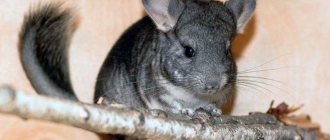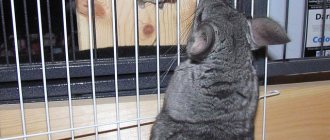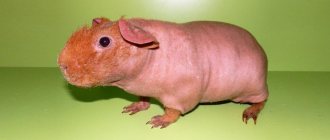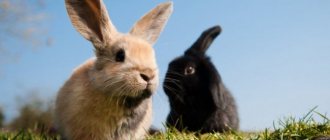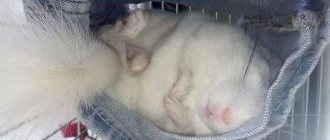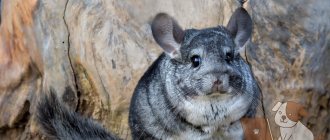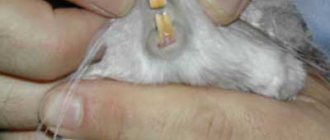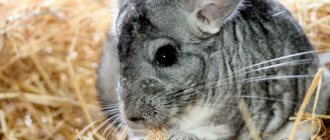The chinchilla is a long-haired rodent native to the Andes mountains of northern Chile. They are a common exotic pet, so many people choose to keep them with other animals, such as cats.
A cat and a chinchilla are unlikely to live in harmony with each other, since they have little in common. Cats are carnivores, and chinchillas are carnivorous animals. Chinchillas will experience stress when surrounded by cats.
They are very different animals, so a lot of research needs to be done to understand their suitability as pets before making a decision. The ultimate goal is for both animals to live happy, healthy lives. It is unfair to have both pets if they cannot enrich each other's lives or live side by side in harmony.
History of the breed
British breed cats were bred in England. Although cats were bred by continental Europeans, the animals were named after Great Britain. The name emphasizes the similarity of the color of the cat's fur with the color of the chinchilla.
There are 2 versions of the origin of the British chinchilla. According to one of them, cats were brought to the British Isles by the Romans. This version gives grounds to assert that this breed is one of the most ancient.
According to another version, cats were bred by the British, methodically crossing animals to get the desired result. For mating they used Persian and gray British cats. The breed was officially introduced in 1889.
The first individuals had a gray color, which was called silver color, later golden chinchillas appeared.
They were abandoned, but now they are a family cats2friends
Let's get acquainted, we are a family cats2friends
: https://instagram.com/cats2friends and each of us has our own story, which we will tell about in the following posts.
goldfish comet - Gagarin.
Write about whom you would like to know more about.
Description
British cats have a round muzzle and wide cheekbones. The animals have a rather large body. The eyes are large, expressive, of various shades of green. The nose is slightly flattened. The ears are small, the fur is thick and long. The neck is short. The limbs appear short due to the long fur on the belly. The pads are powerful and round.
Chinchilla cats tend to be overweight and are easy to overfeed. British chinchillas can hardly be called elegant and graceful. It's more like a cute little bundle of warmth and beauty.
Males are larger than females, the weight of an adult cat reaches 7 kg. Cats weigh around 4 kg. After castration, males gain weight and can weigh 10 kg or more. Females after sterilization weigh up to 8 kg.
The average life expectancy of a British chinchilla is 10-15 years. With good care, a pet lives 20 years.
Color
Experts note 3 main types of chinchilla color:
- golden;
- silver;
- silver shaded.
Less common are marbled, tortoiseshell, fawn, tabby, harlequin, bicolor, and cinnamon cats.
The golden chinchilla cat is less common than its silver relatives. This species has a reddish color on the back, sides and tail. The neck and belly are creamy.
Silver pets are white and 1/3 black. Silver shaded – white with fur darkened by 1/8.
Relationship with the owner
Cats quickly find a common language with their owner and play with children. The British are prone to apathy. The chinchilla cat loves to be given attention and entertained.
If the owner is busy and cannot pay attention to the golden or silver chinchilla, it becomes offended and begins to get bored. The animal loves to be nearby when the owner is reading a book, watching TV, or doing homework. He will sit in your arms exactly as long as he wants.
The cat is imposing, allows itself to be stroked and scratched behind the ears. But he does not tolerate familiarity. As soon as the owner begins to squeeze the cat or tries to pat it, the pet expresses dissatisfaction. They are the kind of animals that allow themselves to be loved and set their own rules.
How to tame a young animal?
The small chinchilla is quite timid, so taming should be gradual and careful so that the animal is not stressed. How to tame a chinchilla at a young age?
It is important to speak kindly to the rodent and often flash before its eyes so that the chinchilla gets used to its owner. But when communicating, you should keep your distance - do not put your face too close to the rodent and do not touch it with your hands. You need to approach your pet at a quiet and slow pace; sudden movements and noise can frighten the chinchilla. At first the animal will behave fearfully
But when he stops hiding, you can try to open the cage door, the movements should be smooth and careful. No taming is complete without treats. Therefore, after 3-4 days, you can give the little chinchilla some tasty treat by opening your palm. After 7 (sometimes 14) days, the chinchilla will take treats from your hands. And only after that you can try to pet her and pick her up. Some owners make a certain sound (for example, clicking) before approaching the cage. After some time, the chinchilla associates this sound with the owner approaching it, which means there will be games or treats ahead.
Mobility
Aristocratic chinchillas would rather lie imposingly than rush around the house. Although they are not averse to frolic, but in moderation. There are no special transition stairs for them, no ropes are laid out so that they have somewhere to spend excess energy. These are pets that decorate the house.
In Western countries, an owner is considered bad if a domestic cat has less than 2 toys. There is no need to count the number of cute objects our cats have, but the animal will feel better if it has its own toys. Stores offer active and educational games for cats. The British are considered to have intelligence. Devices that develop logic have been developed for them. Toys will have to be updated periodically.
Kittens
British breed babies do not have clearly defined coat and eye colors. In childhood, the fur of a golden chinchilla cat can be distinguished. The animal is finally formed by the age of 1.5 years. In an adult animal, the color of the fur and eyes is visible, and it no longer changes with age.
For kittens to develop normally, food must be age appropriate. It is better to use ready-made dry and wet food. Kittens should not be fed cow's milk. For them, it is better to use goat’s milk or diluted in a ratio of 1:3 (where 3 parts are cow’s milk).
Video: Schoolgirls organized a shelter for dogs in the garden
If the name of a medium-sized nursery appears, albeit not often, but regularly, then this nursery deserves attention - it is clear that not all offspring are exhibited. It is difficult to judge a small nursery by the frequency of occurrence of its name.
In order to determine whether breed characteristics are being improved in a nursery and whether the general breed type of animals is changing, it is necessary to collect information about several generations. Occasionally, nurseries “post” their illustrated history on the website (and in these cases, as a rule, it is such that it allows breeders to be proud of their breeding work), but, alas, one cannot count on such a “gift”.
Try to find old photographs in show reports in magazines and yearbooks. You can also contact the breeder himself. If he is confident in the stable progress of breeding in the nursery, he will not refuse to show you photographs of the grandparents of his animals.
— the incidence of hereditary anomalies and diseases is an indicator about which it is most often impossible to collect reliable information. Unfortunately, we usually have to settle for gossip and rumors (often exaggerated).
Evaluation of a specific animal based on exterior and pedigree
With good knowledge, and, what is especially important, understanding of the breed standard, assessing the exterior of an adult animal and its belonging to a certain intra-breed type is not so difficult. Since ideal animals practically never occur (and if they do, a good breeder leaves them in his nursery), then, most likely, the animals offered for sale will have some shortcomings
It is very important to analyze the true nature of the proposed animal's shortcomings. Without this analysis, it is impossible to understand how to correct this deficiency in subsequent generations.
For example, if the ears of a British cat seem too large (relative to the standard), then they may be really large in size, or they may be quite average in size, but incorrectly set (for example, without the necessary forward tilt, which hides the size of the ear).
And incorrect positioning, in turn, turns out to be due, for example, to the too early end of growth of the skull bones.
Bathing
These cats don't like to swim. To keep the coat in good condition, British chinchillas are treated with dry shampoo. The composition is applied to the wool, rubbed in, then combed out with a brush. The powder removes dust, cares for hair, and creates volume. The procedure is performed 2 times a year. Shampoo is selected depending on the shade of the coat. A golden chinchilla will not benefit from a product intended for a pet with silver fur.
British chinchillas do not tolerate regular bathing well. If it is not possible to use dry shampoo, be prepared for a negative reaction from your pet to water. To create maximum comfort, a cloth is placed under the cat's paws. The animal clings to the lining with its claws, does not slip and feels more calm.
When bathing your Briton, make sure that the shampoo does not get into the eyes and ears.
Diseases: how dangerous they are and how to treat them
These animals have strong immunity, which is why, with proper care, they rarely get sick. But being in unfavorable conditions can negatively affect their well-being. If the animal experiences a loss of appetite and decreased activity, this is a cause for concern. The following diseases are typical for chinchillas:
- Bronchopneumonia is accompanied by fever, difficulty breathing, nasal discharge, cough and wheezing. The animal is treated with glucose and vitamins. And also small doses of penicillin. This drug is prescribed intramuscularly once every three days. The dosage must be agreed with your veterinarian.
- Rectal prolapse. This causes constipation. The fallen part is first treated with furatsilin solution, then with paraffin oil and, using a pipette, carefully set.
- Formation of hair rings around the male genitals. This prevents it from reproducing. The rings are removed by hand. If they are dry, they are treated with a soap solution.
- Constipation. It can be caused by a lack of fluid and changes in diet. If there is such a problem, dry food is excluded. The pet is given a laxative and paraffin-based oil is injected into the mouth or rectum.
- Keratitis is a lesion of the cornea of the eyes. The disease occurs due to contact of the chinchilla with poor-quality sand or mechanical damage. The eyes are washed with furatsilin and treated with levomecithin or tetracycline ointment.
- Dental diseases occur when there is no stone to grind down. The animal's incisors reach 8 cm and injure the tongue. The molars move. The chinchilla is unable to eat and dies. Treatment involves grinding down the teeth, but this procedure must be performed by a veterinarian.
- Conjunctivitis manifests itself as purulent or clear discharge from the eyes. May indicate the presence of an infection. The animal's eyes are instilled with fluorescent, then treated with eye ointment every hour.
- Ticks. They can be detected after careful observation of the animal. The chinchilla's skin peels off and becomes thicker, and the animal suffers from itching. The animal loses weight, and in the absence of adequate treatment, dies. The wool needs to be cut, and the affected areas should be treated with bromocyclene at intervals of 8 days. The dosage is prescribed by the veterinarian. You will also need to disinfect the cage.
- Flatulence occurs as a result of feeding poor quality food. The animal's temperature drops to 34.5°C, and its general condition worsens. The animal is given activated carbon in powder form. You can use dill water or chamomile infusion. It is better to coordinate treatment with your veterinarian.
- Otitis is an inflammatory process that affects the external auditory canal. It is the result of pollution. The disease can be detected by the leaking brown liquid. The ear is treated with fish oil and ointment containing zinc.
- Diarrhea – occurs due to stress and unbalanced nutrition. The animal's temperature rises. He is given oak bark, maple leaves and activated carbon.
- Heatstroke. This ailment can be recognized by observing the behavior and appearance of the animal. It lies on its side, the ears turn red, and copious amounts of saliva appear. The chinchilla is moved to a cool place and a cold object is placed in the cage. For example, a bottle filled with cold water.
- Ringworm – baldness appears on the back, sides, head, neck and tail. The skin peels and becomes inflamed. The animal is treated with a 5% iodine solution, medical sulfur or fungistop.
Hygiene
The chinchilla cat quickly learns to use the litter box. Sand or filler is changed frequently. If the animal feels that the litter is stale, it will find a corner and relieve itself there. Don't scold the British in this case.
Ears and eyes require special care. The ears are cleaned with a cotton swab moistened with warm water once a week or as they become dirty. The eyes are wiped with a cotton pad soaked in warm water. You can use wet wipes for this if they do not contain fragrances or other synthetic additives. They can harm your cat's mucous membranes.
The claws are cut off as needed using a nail clipper. If they peel off, it means that the diet requires correction and the chinchilla does not receive the necessary nutrients. To keep claws in good condition, make a scratching post at home.
Nutrition
To keep your pet's coat in good condition, the British chinchilla needs special nutrition. The best option is dry food. It is chosen depending on the age and gender of the pet.
Castrated and sterilized animals require special food. Manufacturers produce food for such animals. If feeding is homemade, it should be low-calorie, since processed animals are famous for their large appetites and are prone to becoming overweight. In addition, their hormonal levels are disrupted and this is taken into account when feeding.
If you plan to use homemade food, the chinchilla’s menu should include cereals, meat, fish (sea, as river fish can have parasites), and vegetables. Raw meat should not be given to cats. The product may contain worm eggs, and the animal will become infected with parasites.
A Briton should have constant access to clean water and his dishes should always be clean.
To keep their fur in good condition, cats are given eggs. Natural proteins and protein strengthen the roots, hairs do not grow so abundantly. With this diet, the fur of a silver or golden chinchilla becomes shiny and denser. Quail eggs are preferable to chicken eggs. But not everyone can afford to feed their cat quail eggs.
Is it possible to keep these two animals in the same room?
A properly adapted chinchilla and cat can get along even in tight spaces. Typically, cat owners look down on domestic rodents. But at the same time, they treat chinchillas condescendingly, preferring not to pay attention to them. The situation is good - there is peace and quiet in the house, no one is hunting anyone, no one is fighting with anyone.
However, there are often cases when rodents themselves provoked the cat into active actions. Rodents succeed in awakening a dangerous predator in their domestic pussy when the animal lacks a sense of proportion and its behavior crosses the boundary of what is acceptable. The most common reasons for starting hunting:
- Excessive curiosity - when a small animal tries too hard to get to know the cat better.
- Rudeness is when a rodent that has become accustomed to a new territory demonstrates disrespect for the other inhabitants of the house and tries to show itself as the boss.
Article on the topic: Is it worth getting a chinchilla: the pros and cons of a pet in an apartment
Regardless of what exactly provoked the hunt or just a conflict between the animals, the owner can only place the pets in different rooms and make sure that they do not intersect again.
Health
British chinchillas are distinguished by good health. These are hardy animals that are not afraid of frost and wind. Warm and thick wool reliably protects pets from the vagaries of the weather. But it’s better not to take your fluffy for a walk in the rain or slush.
Like all cats, chinchillas suffer from kidney disease. Bring your pet to the veterinarian periodically to detect pathology at an early stage.
The British have watery eyes, and this is taken into account when purchasing a kitten, since the eyes will require care.
What is a chinchilla?
According to the description of the Oxford Academic Institute, the chinchilla is a hystricomorphic rodent of the family Chinchillidae, a high-altitude species found in the foothills of the Andes in northern Chile and southern Bolivia at an altitude of 3,500 - 5,000 meters. They are social creatures, living in colonies of up to 100 individuals in underground tunnels or rock crevices.
Chinchillas have soft, long, thick fur that is bluish, pearly, or brownish-gray in color. Regardless of the color of a chinchilla's fur, the tips will always be black. Unfortunately, chinchilla fur became popular in the 1700s, and as a result, hunting of this animal was driven to near extinction. In the 1900s, Argentina, Bolivia, Chile and Peru banned hunting of wild chinchillas, and their numbers have increased since then.
Because of their thick fur, chinchillas can tolerate cold temperatures, but have difficulty surviving temperatures above 80 F (27 C). This is because they are at too great a risk of heatstroke and other heat-related illnesses.
Chinchillas are midnight and nocturnal creatures that prefer peace and quiet during the daytime. They spend most of their time sleeping, as they are most active at dawn or dusk. As omnivores, they eat both plants and meat, including grass, seeds, insects and bird eggs. They hold food with their front paws and gnaw at it like mice.
Subtleties of choice
Golden chinchillas are more expensive than silver cats. To avoid disappointment in your pet:
- buy a kitten from trusted breeders;
- find out who the kitten's parents are;
- find out in what conditions the baby is growing up and what illnesses the parents had;
- ask when and what vaccinations the kitten received;
- good breeders have passports for all animals - when buying a small animal, ask to see its passport;
- check deworming data;
- if the baby costs less than $400, this indicates a defect in the breed, or a half-bred animal;
- There are no British fold chinchillas (Scottish chinchillas have this feature);
- If you do not plan to participate in exhibitions, pay more attention to the health of the baby, and not to the color.
In order for the kitten to develop normally, it is kept with its mother for up to 3 months. Younger animals should not be purchased.
The British chinchilla will become a good friend who does not tolerate fuss. Complaisant and not very active pets will happily lie next to their owner, play with the child, but will communicate on their own terms.
We recommend viewing
Do cats get along with ferrets?
[The Ultimate Guide to Dating] Do Cats Get Along with Hamsters? [Complete Guide] Do Cats Love Huskies?
However, never risk getting too close to your chinchilla. If the cat's hunter instinct kicks in, it will only take a few seconds before it pounces on the rodent and causes serious harm to it.
Give animals space
Allow your cat and chinchilla to meet face to face only for short periods of time. And after they've spent some time with each other, give them plenty of space between their next meetings. Your chinchilla will likely feel fearful after being in the cat's presence and will need time to recover.
Your cat also needs to get into a routine where she can leave the chinchilla alone. Neither animal will have a good quality of life if one is desperately hunting and the other is being hunted. Give the chinchilla one room and prohibit the cat from entering there.
Always keep an eye on your cat
In this scenario, your cat is an animal that cannot be trusted. Her hunter instincts are too strong and unpredictable. Older cats may behave better, but there is always a risk that one day they may turn on the chinchilla. Although your pet chinchilla will most likely be safe in his cage, accidents can happen. And when they happen, it's heartbreaking for everyone involved.
Your chinchilla may not associate being in a crate with feeling safe, so he may feel stressed and anxious whenever a cat is around. This is an unfair lifestyle for a chinchilla, so both animals must be separated unless you can keep an eye on what the cat is doing.
Will a cat eat a chinchilla?
If a cat manages to catch and kill a chinchilla, there is a chance that it will eat it. However, not all cats eat their prey. Some cats kill animals purely for fun, while others give their kills as gifts. In most cases, the likelihood that a cat will eat a chinchilla's prey or not depends on its personality. The following are common reasons why a cat hunts:
Instinct
Hunting is an instinct. Even domestic cats kill small birds and mice. This is because they are descendants of the African wild cat and while living in the wild they had to hunt in order to survive. Today, our pets are bred from the best cat breeds - the survivors - and have retained their predatory instincts despite various breeding programs.
Predatory play with your cat that encourages chasing and attacking actually promotes these instincts. Your cat may be having fun, but she's also learning what to do in anticipation of finding small animals to kill. Replacing feather and mouse toys with puzzles will help keep your cat entertained while teaching her not to hunt.
Some cats hunt because they enjoy chasing prey and see it as fun, especially those cats whose owners use toys that resemble birds and mice to play with their pets. They don't view small animals like chinchillas as food, but rather as something to chase. Chasing gives your cat an adrenaline rush and a thrill that can become addictive over time.
Some cats play with prey because they have never been shown how to kill. Kittens learn to chase and tackle their kittens as they grow, and carry these skills into adulthood.
But what they don't learn is how to immobilize their prey and deliver the killing blow. Wild cats learn this skill from their mothers, who kill prey presented to them by their kittens with a fatal bite. Domestic mother cats who receive food from people will never have to do this in the presence of their kittens, so these skills are lost to some extent.
Food
Like their wild ancestors, many domestic cats hunt for food. This is more common in feral or stray cats that rely on their hunting skills to find food. Since wild chinchillas are not found in the same regions as cats and most are kept as pets, the likelihood of a chinchilla hunting for food is extremely low. Most likely, a chinchilla will be an excellent sport for a cat.
However, voracious cats or cats that do not receive enough nutrition from their owners may eat small rodents if they are caught. Cats are obligate carnivores, which means they must eat meat to survive and meet their nutritional needs. Cats are solitary hunters, so they seek out small predatory animals that they can quickly kill alone. Indoor cats can turn to alternative food sources to get the nutrition they need.
Gifts for people
Although it is very unpleasant, it is not uncommon for a cat to bring a dead animal home to its owners. Spayed females are more prone to this. This is because they have an instinct to bring dead animals home to their kittens, but they have no kittens to bring the animal to. Therefore, some people believe that they are being left some kind of gift.
And in some cases, a killed rodent really is a gift. Cats share their bounty with their family, which in this case is you.
Can chinchillas get fleas from cats?
Fleas spread easily between animals. Since pet chinchillas do not spend time in the wild, they can only get fleas from other animals, including cats. Infection occurs through contact, but contact does not have to be direct for fleas to jump onto the skin of another animal.
If your cat and chinchilla spend time in close contact, cats that roam outside can easily pass fleas to the rodent. Fleas can also live in upholstery and carpets. If the cat brought fleas from the street, the chinchilla can pick them up while wandering around the room.
However, the good news is that because chinchilla fur is so thick, it is difficult for fleas to penetrate it. This makes infestations unlikely, but chinchillas can still pick them up. This is another reason why cats and chinchillas should be kept separately.
Fleas are a problem for both cats and chinchillas and can cause the following problems:
Anemia and low iron levels
Fleas are bloodsuckers and can consume up to 15 times their body weight in blood. Pale gums and a general lack of energy are two significant signs that your pet is suffering from low blood iron levels.
Tapeworms
These are flat, segmented worms that live in the intestines of some animals. They absorb nutrients from the intestines and can cause irritation in a sick animal.
Cat scratch fever
It is a bacterial infection that mainly affects humans and is transmitted through cats. According to the Centers for Disease Control and Prevention, about 40% of cats will develop this infection at some point in their lives. It is not serious for cats, but an infected person may have swollen lymph nodes, headaches, fever, lethargy and joint pain.
